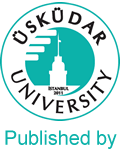Makale
Makale
İstanbul’da Demografi ve Göç (1840-1842): İstanbul’un Aylık Nüfus Raporları Üzerine Bir Analiz Denemesi
Demography and Migration in Istanbul (1840-1842): An Analytical Essay on Monthly Population Reports of Istanbul
Yunus Emre ÇAKIR
Yıl 2022, Sayı 15, Sayfalar:243-268
This article deals with the monthly population reports in order to describe the demographic view of Istanbul soon after the proclamation of the Edict of Tanzimat. Monthly population reports, in the simplest terms, were the jurnals that present the birth, death, incoming and outgoing migration (transported population) of the population and the amounts of subjects and foreigners visiting Istanbul as guests. The data presented by the reports on the population of Istanbul, including Bilâd-ı Selâse (Eyüp, Galata and Üsküdar), which consists of Muslim, Greek, Armenian, Catholic, Jewish and Gypsy elements, were analyzed according to various parameters. Various inferences have been made on issues such as the distribution of the population of Istanbul according to religious communities/nations, arithmetic increase/decrease trends, adult/child mortality rates, geographical mobility and migration. Findings on geographical mobility were shared, based on the data on immigration (transfer of population) and arrivals/departures between Istanbul and the provinces in the reports. As a result of the study, it has been concluded that the population of Istanbul exhibits negative natural growth characteristics, so qualified immigration from the provinces was needed in order to keep its population and labour force dynamics. According to the average of all reports, the Muslim population, which constitutes 46,5% of the total Istanbul population, had the lowest birth rate and the lowest male birth rate per adult male. In addition, based on the report, an attempt was made to calculate the total population of Istanbul.
Bu makale Tanzimat Fermanı’nın okunmasından hemen sonra İstanbul’un demografik görünümünü tasvir etmek amacıyla aylık nüfus raporlarını ele almaktadır. Aylık nüfus raporları en sade anlatımla, doğum, ölüm, gelen ve giden göç (nakl-i nüfus) ile İstanbul’u misafir olarak ziyaret eden tebaa ve yabancıların miktarları gibi nüfus üzerinde meydana gelen değişimleri sunan jurnallerdir. Müslüman, Rum, Ermeni, Katolik, Yahudi ve Roman unsurlardan oluşan Bilâd-ı Selâse (Eyüp, Galata ve Üsküdar) de dâhil olmak üzere İstanbul nüfusu hakkında raporların sunmuş olduğu veriler çeşitli parametrelere göre analiz edilmiştir. İstanbul nüfusunun dinî cemaat/milletlere göre dağılımı, aritmetik artış/düşüş eğilimleri, yetişkin/çocuk ölüm oranları, coğrafi hareketlilik ve göç gibi konularda çeşitli çıkarımlar yapılmıştır. İstanbul ve taşra arasındaki göç (nakl-i nüfus) ve misafirlik kapsamında değerlendirilen geliş/gidişlere dair veriler üzerinden coğrafi hareketliliğe dair tespit edilen bazı bulgular paylaşılmıştır. Çalışma sonucunda İstanbul nüfusunun negatif doğal büyüme özelliği sergilediği dolayısıyla nüfusunu ve işgücünü dinamik tutabilmek adına taşradan alınacak nitelikli göçe muhtaç olunduğu sonucuna varılmıştır. Tüm raporların ortalamasına göre toplam İstanbul nüfusunun %46,5’ini oluşturan Müslüman nüfusun en az doğum ve yetişkin erkek başına en az oğlan çocuğu oranına sahip olduğu görülmüştür. Ayrıca rapordan hareketle İstanbul’un toplam nüfusunu hesaplama girişiminde bulunulmuştur.

